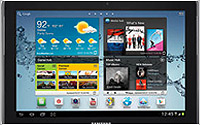 Internet-connected devices are
exploding in the United States.
Internet-connected devices are
exploding in the United States.
There are 31.8 million Internet-accessible tablets, according to The NPD group, and IDC
estimates with global tablet shipments rising 142% in the first quarter of 2013, the post-PC era shows no signs of slowing.
The insights support findings in the Monetate EQ1 2013 that looks at
social commerce to provide deeper insights on consumers and customers. It analyzes tablet commerce to determine how Android devices can grab more tablet traffic from iPads.
Brand-specific
trends around tablets have begun to emerge. Google estimates 900 million Android activations by the end of this year. Visits from Android tablets have almost doubled in one year, while traffic from
iPads remains flat, according to the report.
advertisement
advertisement
Not only are searches and traffic from Android tablets continuing to increase, the average order value of shoppers using these devices continues to
gain ground, compared with consumers purchasing from iPads. A year ago, iPad users spent nearly 18% more than shoppers on Android tablets. In Q1 2013, iPad users spent just 3.7% more than Android
shoppers.
Interestingly, consumers on average spent about $106 from Macs vs. Windows at $98. Compare that with $107.14 and $107.03 for Android smartphone vs iPhone, respectively.
Marketers can also benefit by becoming customer-centric, rather than worrying about conversions. The study found that increasing engagement and loyalty creates a longer customer lifetime and higher
value. Understanding location to customize segments, such as distance to closest store or competitor, yields bigger returns. In turn, retailers that promote hassle-free in-store return policies can
develop a more personal relationship with consumers.
A trend toward supporting military personal also has begun to emerge. Retailers with the ability to bridge the gap between ecommerce and
in-store sales and returns also have an opportunity to serve U.S. military personnel and their families stationed on bases worldwide often in remote locations, according to the report.
While
they're still a small percentage of overall traffic to ecommerce Web sites, armed forces personnel stationed in Europe convert at 4.3%, much higher than the average conversion rate for all consumers
shopping in the United States, about 2.5%. The average order value for visitors who reside on military bases around the world is 23% higher than the average order value of shoppers across the
United States.